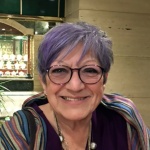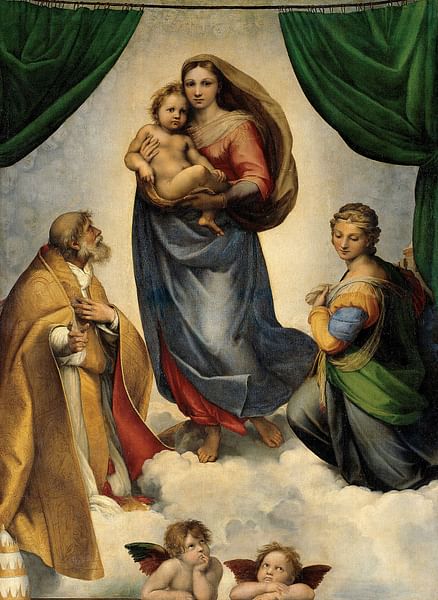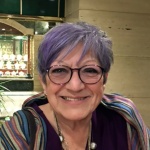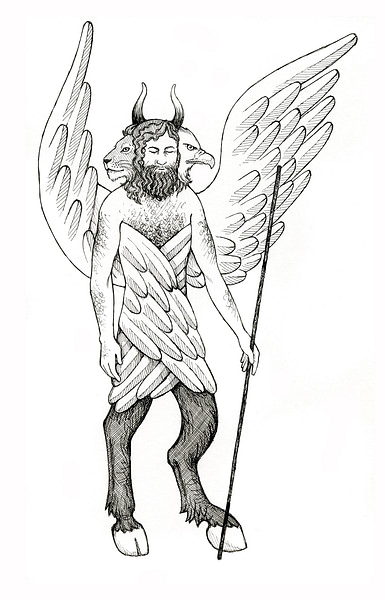
A cherub (pl. cherubim) was a divine being who dwelt in the heavenly realm of the gods, either as a servant or a mediator between humans and the divine. The word most likely derived from the Akkadian karabu ("to bless"). The cherubim are often coupled with other beings known as seraphim who guarded and protected the courts and thrones of the gods. Over time, both cherubim and seraphim became denoted as angels, from the Latin angelos ("messenger").
The Ancient Universe
All ancient cultures had a concept of a three-tiered universe which included:
- the heavens – the abode of the gods
- earth – the abode of humans
- the netherworld – the land of the dead
The heavens were densely populated with gradients of divinity, and a higher god or sometimes a king of the gods ruled above various lower divinities. These lower divinities were assigned power over elements of daily life, such as agriculture and the birth process (mother-goddesses). At the lower level were daemons (demons), who were originally neutral but were eventually blamed for evil.
Because all these powers were above humans, they could directly influence the lives of the people. They were also understood as transcendent, meaning they had the ability to navigate all three layers, including the land of the dead. To appease the powers in heaven and to plea for benefits in daily life, ancient religious systems developed the concept of sacrifices.
Ancient Mesopotamia/Persia
The land of the two river basins of the Tigris and the Euphrates, collectively known as Mesopotamia, produced early empires such as the Akkadians, Hittites, Assyrians, Babylonians, and the Persian Empire. Divine cherubim were portrayed as anthropomorphic (human-looking), large and ferocious to instill fear, with the addition of war helmets and wings. They were also associated with the statues of griffins, sphinx-like creatures with human heads but the body of a lion.
Each subsequent empire absorbed older religious traditions. The state cult of Persia was Zoroastrianism, which claimed that the original creator god, Ahura Mazda, emanated paired beings in the universe who were responsible for physical creation, the Amesha Spenta.
As the polar opposite of Ahura Mazda, was the concept of druj (chaos), which was under the power of Ahriman. Zoroaster taught that the entire universe (including life on earth), was a constant battle between these forces of good and evil. When Babylon destroyed Jerusalem in 587 BCE, Jewish captives were taken to Babylon but then were ruled by the Persian Achaemenid Empire when Cyrus II (r. c. 550-530 BCE) conquered the Babylonians. The Jews borrowed many of the earlier ideas, most notably, the Zoroastrian concept that each individual had a guardian angel (which now acquired wings), while the figure of Ahriman became the origin of Satan, the devil.
The Jewish Scriptures
The earliest levels of Jewish literature portrayed such a divine being as mal'ach ("messenger") who appeared in human form. Although divine, these messengers were always subordinate to God (Yahweh) and carried out his will. The term cherub (and cherubim) occurs 90 times in the Jewish Scriptures. They are often assigned specific jobs, such as guarding the entrance to the Garden of Eden after Adam and Eve were expelled (Genesis 3:24). In the period known as Second Temple Judaism (450 BCE to 70 CE), some of the cherubim (and seraphim) were given names and elevated to the status of archangel (Gabriel, Uriel, Michael). In Samuel 2:22 and Psalm 18, they help transport God when he descends to intervene in human affairs on earth.
When Moses received the ten commandments on Mount Sinai, God told him to create images of cherubim when he built the Ark of the Covenant to hold the tablets (Exodus: 25:18-22). In all depictions of this, two cherubim sit atop the Ark, with wings outspread. They were understood to be sculpted in gold. When King Solomon built the First Temple in Jerusalem (10th century BCE), this iconography was dominant in the Temple complex. According to later Rabbinic traditions, the art appeared on the curtain which separated the holy of holies (the tabernacle) from the larger complex.

This period also saw the development of the concept of the mercy seat, the space between the cherubim, where God's literal, physical presence was believed to dwell in the Temple, above the cherubim. (1 Kings). This combined with the concept that mercy could be administered by God through both the sacrificial system as well as his presence. This produced the idea that the Temple was a sacred space, requiring states of ritual purity for entering the various zones.
The most detailed description of the cherubim is found in the book the Prophet Ezekiel (6th century BCE). He was a priest who lived under the Jewish exile in Babylon, where he had earlier prophesized the eventual destruction of the Temple and Jerusalem by the Babylonians (587 BCE). His description of the cherubim places them underneath the throne of God:
In my thirtieth year, in the fourth month on the fifth day, while I was among the exiles by the Kebar River, the heavens were opened, and I saw visions of God ... I looked, and I saw a windstorm coming out of the north – an immense cloud with flashing lightning and surrounded by brilliant light. The center of the fire looked like glowing metal and in the fire was what looked like four living creatures. In appearance their form was human but each of them had four faces and four wings. Their legs were straight; their feet were like those of a calf and gleamed like burnished bronze. Under their wings on their four sides they had human hands. All four of them had faces and wings and the wings of one touched the wings of another. Each one went straight ahead; they did not turn as they moved.Their faces looked like this: Each of the four had the face of a human being, and on the right side each had the face of a lion, and on the left the face of an ox; each also had the face of an eagle. Such were their faces. They each had two wings spreading out upward, each wing touching that of the creature on either side; and each had two other wings covering its body. (Ezekiel 1:1-11)
Understandably, artists have traditionally had problems portraying this vision, with its simultaneous movements. The later Rabbinic views of Kabbalah mysticism provided many more details of these cherubim in a collection of texts known as the Zohar. All of them are given names and described with their areas of domination.
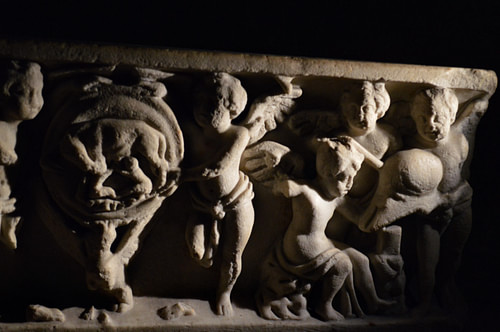
Cherubim in Christianity
The term 'cherub' does not appear in the New Testament, but it is inherent in the collective term 'angels'. In Matthew's gospel, an angel appears to Joseph in dreams several times. They protect the righteous (Matthew 4:6) and are warriors for God (26:53). Luke has an angel appear to the father of John the Baptist, Zechariah, to inform him of the birth of a son, and the angel Gabriel appears to Mary to foretell the birth of Jesus Christ. A choir of angels appears to the shepherds in the fields who announce the good news. In the gospels, Mark, Matthew, and Luke have the angels ministering to Jesus when he was tempted in the wilderness.
In his parable of the rich man and Lazarus, "the poor man died and was carried by the angels to Abraham's side" (Luke 16:22). This was a concept where divinities acted in the role of a psychopomp, a conveyor or conductor of souls in the afterlife (such as the god Hermes in Greek mythology). Mark, Matthew, and Luke all have angels at the tomb of Jesus, and the angels are the ones who announced his resurrection.
Christians adopted the Jewish concepts of the hierarchy of these beings in heaven, a nine-layered heavenly hierarchy, but with seraphim as the highest, and the cherubim in the second order. With the rise of the cult of the saints (the martyrs who were now in heaven) in the 4th century CE, both angels and saints could act as mediators in the court of God for believers. The medieval theologian, Thomas Aquinas (1225-1274), claimed that the seraphim were highest in their zeal for carrying out the divine will, while the cherubim were associated with various levels of knowledge.
Islam & Non-Western Religions
In the sacred text of Islam, the Quran, the cherubim are a class of angels whose primary function is to continually praise God. They also intercede for humans. Cherubim are described as dwelling in the sixth heaven or around the throne, where four of the cherubim are bearers of the throne. Prophet Muhammad (l. 570-632 CE) experienced an out-of-body journey to heaven and described various hierarchies of angels. Absorbing cultural/religious elements, the divinities are human in appearance but larger and more powerful. A difference in Islam regarding these beings is that Muhammad taught that God created three sentient beings who are able to perceive and feel things: jinn, angels, and humans. Jinn were powers in pre-Islamic Arabic mythology, often blamed for human misfortune or diseases. Jinn and humans were given free will, but angels were not; they were compelled to carry out the divine will.
Many other religious cultures of the world have similar ideas concerning a diversity of divine beings that both inhabit the heavens and serve as mediators in the human realm. The religions of Asia, Africa, Oceania, and the Americas claim both benevolent and at times malevolent divine beings. An equivalent to the Western tradition of angels is found in the devas of Hinduism, avatars of Brahma, Vishnu, and Shiva. Lesser devas control nature.
Putto in Renaissance Art
In the Western tradition, the most common iconography of a cherub is a work of art described in Italian as putto (pl. putti), a naked, chubby boy, often depicted with wings. They were associated with Eros, the son of Aphrodite. Eros meant "desire", the physical urgings of the body, and he had a popular role in romancing and love-making, shooting his arrows that motivated the procreative principle and falling in love. Eros became Cupid in Roman religion. The putto figure was often sculpted on the sarcophagi of children where they were shown dancing and playing.
During the period known as the Renaissance (14th-17th century), Europeans rediscovered classical philosophy, literature, and art. This coincided with the earliest discoveries of tombs and excavations of older villas and monuments, where these figures were popular as wall decorations, such as at Pompeii. The revival of the putto is credited to Donatello (1386-1466) in the 1420s, and then Raphael (1483-1520). Raphael's Sistine Madonna has two cherubim at the bottom, which is popular in the commercialization of these figures. This reflects the modern coupling of the Roman Cupid with the holiday of Valentine's Day. Such cherubim have come a long way from the ferocious depictions of the guardians of the gods to the cute, charming, impish concepts of love.
